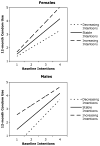An expanded model of the temporal stability of condom use intentions: gender-specific predictors among high-risk adolescents
- PMID: 21347619
- PMCID: PMC3140620
- DOI: 10.1007/s12160-011-9266-0
An expanded model of the temporal stability of condom use intentions: gender-specific predictors among high-risk adolescents
Abstract
Background: Adolescents involved with the criminal justice system are at particularly high-risk for the Human Immunodeficiency Virus and sexually transmitted infections.
Purpose: The purpose of this study was to longitudinally examine gender-specific models of condom use, incorporating temporal stability of intentions.
Methods: Adolescents on probation (N=728) were recruited to complete longitudinal surveys including measures of Theory of Planned Behavior and gender-specific constructs, relationship length, and condom use.
Results: Gender-specific models of condom use behavior suggested by previous research were mostly replicated. For young women, the effect of baseline intentions on subsequent condom use behavior was stronger when intentions were either stable or increasing. For young men, more stable, increasing intentions were directly associated with more condom use. There was preliminary evidence to suggest an association between temporal stability of intentions and decreasing condom use in stable relationships.
Conclusions: Intervention efforts should be tailored by gender and aim to forestall decreasing intentions and condom use over time by addressing difficulties in maintaining condom use.
Conflict of interest statement
Figures




Similar articles
-
Predictors of condom use in sexually active adolescents.J Adolesc Health. 1992 Dec;13(8):651-7. doi: 10.1016/1054-139x(92)90058-j. J Adolesc Health. 1992. PMID: 1290763
-
Beliefs about condoms and their association with intentions to use condoms among youths in detention.J Adolesc Health. 1994 May;15(3):228-37. doi: 10.1016/1054-139x(94)90508-8. J Adolesc Health. 1994. PMID: 8075093
-
Relationships between marijuana dependence and condom use intentions and behavior among justice-involved adolescents.AIDS Behav. 2013 Oct;17(8):2715-24. doi: 10.1007/s10461-013-0417-0. AIDS Behav. 2013. PMID: 23370834 Free PMC article.
-
Intention to use condom, cusp modeling, and evaluation of an HIV prevention intervention trial.Nonlinear Dynamics Psychol Life Sci. 2013 Jul;17(3):385-403. Nonlinear Dynamics Psychol Life Sci. 2013. PMID: 23735493 Free PMC article.
-
Adolescent condom use, the health belief model, and the prevention of sexually transmitted disease.J Obstet Gynecol Neonatal Nurs. 1996 Jan;25(1):61-6. doi: 10.1111/j.1552-6909.1996.tb02514.x. J Obstet Gynecol Neonatal Nurs. 1996. PMID: 8627404 Review.
Cited by
-
Social science aspects of contemporary HIV/AIDS research.Int Public Health J. 2012 Oct-Dec;4(4):363-366. Int Public Health J. 2012. PMID: 31131074 Free PMC article. No abstract available.
-
Sexual risk-taking and subcortical brain volume in adolescence.Ann Behav Med. 2018 Apr 19;52(5):393-405. doi: 10.1093/abm/kax027. Ann Behav Med. 2018. PMID: 29659656 Free PMC article.
-
Applying the Theory of Reasoned Action to Understanding Teen Pregnancy with American Indian Communities.Matern Child Health J. 2017 Jul;21(7):1449-1456. doi: 10.1007/s10995-017-2262-7. Matern Child Health J. 2017. PMID: 28238193 Free PMC article.
-
Developmental Cognitive Neuroscience of Adolescent Sexual Risk and Alcohol Use.AIDS Behav. 2016 Jan;20 Suppl 1(Suppl 1):S97-108. doi: 10.1007/s10461-015-1155-2. AIDS Behav. 2016. PMID: 26290051 Free PMC article. Review.
-
Testing an expanded theory of planned behavior model to explain marijuana use among emerging adults in a promarijuana community.Psychol Addict Behav. 2015 Sep;29(3):576-89. doi: 10.1037/adb0000098. Epub 2015 Jul 13. Psychol Addict Behav. 2015. PMID: 26168227 Free PMC article.
References
-
- Weinstock H, Berman S, Cates W. Sexually transmitted diseases among American youth: Incidence and prevalence estimates, 2000. Perspectives on Sexual and Reproductive Health. 2004;36:6–10. - PubMed
-
- Centers for Disease Control and Prevention. Sexually Transmitted Disease Surveillance, 2008. Atlanta, GA: U.S. Department of Health and Human Services; Nov, 2009. [accessed 10/14/2010]. Available at http://www.cdc.gov/std/stats08/adol.htm.
-
- Tolou-Shams M, Brown LK, Gordon G, Fernandez I, Project SHIELD Study Group Arrest history as an indicator of adolescent/young adult substance use and HIV risk. Drug & Alcohol Dependence. 2007;88:87–90. - PubMed

